Spring Festival(英文版春节介绍)备课讲稿
春节英文介绍ppt课件

In addition to pasting paper-cuts on windows, it is common for Chinese to paste the character “fu (福)”on walls or doors. “Fu” shows people’s yearning toward a good life. Some people even invert the character “fu” means "fu" arrive in Chinese.
Spring Festival traditional food
With the development of mobile communication, more and more people are using instant messengers such as QQ, WeChat, microblog and so on to express their good wishes to relatives or friends who are far awar. A lot of interesting emoji(表情包) are created to make the atmosphere active.
Also, pictures of the gods of doors will be posted on front doors to ward off evil spirits.
用英文介绍春节的演讲稿
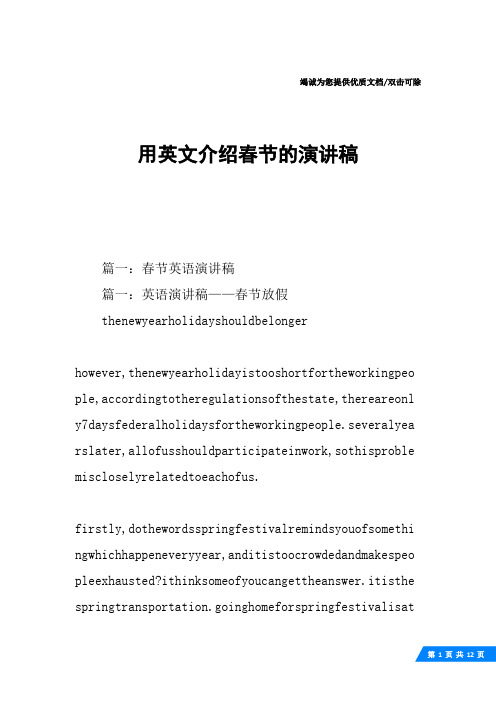
竭诚为您提供优质文档/双击可除用英文介绍春节的演讲稿篇一:春节英语演讲稿篇一:英语演讲稿——春节放假thenewyearholidayshouldbelongerhowever,thenewyearholidayistooshortfortheworkingpeo ple,accordingtotheregulationsofthestate,thereareonl y7daysfederalholidaysfortheworkingpeople.severalyea rslater,allofusshouldparticipateinwork,sothisproble miscloselyrelatedtoeachofus.firstly,dothewordsspringfestivalremindsyouofsomethi ngwhichhappeneveryyear,anditistoocrowdedandmakespeo pleexhausted?ithinksomeofyoucangettheanswer.itisthe springtransportation.goinghomeforspringfestivalisatraditionalcustomofchinesepeople,butmillionsofpeople stravelsbringagreatpressureontraffic,especiallyinsu chashorttime.7daysholiday,4daysontheway.buttheresourcesofthetick etsareverylimited,sothepeoplewhocanbuytheticketsare welloff,otherswhoarenotluckyenoughtogettheticketqui cklyshouldspendthenewyearinastrangeland.secondly,infact,shortvacationofthespringfestivalhas broughtalotofseriousproblems.whentheofficialannounc edtheplanofthenewyearholiday,xinlang,afamousmediadi dasurveyonthesatisfactiondegreeofit,morethan70%ofth epeoplearedissatisfiedwiththeplan.mostofthemwantedm oretimeforrelaxed,ortheywouldhavelesspassionforthei rworkinthenextyear.anetizencalledteemosaidhealwaysf eltangrywheneveryyearhesaidgoodbyetohisfamilyandcam ebacktowork.so,wecanexpect,ifthenewyearholidaycanbelongerforthe workingpeople,maybeitwillmakethereunionoffamiliesmo reconvenientandletpeoplecelebratethespringfestivalwithagoodmood.also,theproblemswementionedabovecouldb esolved.thankyou!篇二:英语演讲春节thespringfestivalgoodafternooneveryone.i’mwuyunfei.today,i’lltalkaboutthetopicaboutspringfestival.inmyopinion,thespringfestivalasthemostinfluentialtr aditionalfestivalhaveimportantmeaningforus.severald aysbeforethenewyear,peoplebegintoprepare.farmerskillpigs,sheep,cocksandhens.citydwellersbuymeatfishandvegetables.h ousesarecleaned;coupletsare(春联)postedonthedoors.colorfullanternsarehungatthegat e.allfamilymemberswillgettogetheronnewyearevetohave abigmeal.duringwhichpeopledonotworkexceptforthework ersonduty.studentsdonotgotoschool,andshopsareclosed .atthesametime,everyonecelebratestoeachother.whenpe oplemeetontheway,theysaytoeachotherhappynewyear..atabout12oclock,someparentsandchildrenlightcrackers.thewholeskyisli ghtedbrightly.wemaywatchthefireworksexcitedly.howbu syitis!onthefirstearlymorningofoneyear,friendsandrelativespaynewyearcallsandgivespresentst oeachother.atthattime,childrenarethehappiestbecausetheycangetmanyredpacke tsformtheirparents,grandparents,uncles,auntsandsoon.各位——、女士们、先生们、同志们、朋友们:大家好!一元复始、万象更新。
介绍春节的英文演讲稿

介绍春节的英文演讲稿探讨演讲对学生语言综合能力的培养,包括口语、听力、阅读和写作能力的提升,发现英语演讲在英语教学中占有非常重要的地位。
下面是店铺为你整理的介绍春节的英文内容,希望对你有帮助。
介绍春节的英文演讲稿一When clock is belling,my heart ripple along with it,to distant with you,transmit my missing,to be joyful!My dear friend!Please open the window,let the new year's wind blow your room and the snow flying in,my warming wish flutter to your heart!Flowers are disseminationing fragrant,friendship transmissing warm,hope us to brimming in a happy year,wishes you: Happy New Year! Best wishes! Does not experience the wind and rain, how can see the rainbow?nobody can casually succeed!So refuel!The same as New year!Missing are a smell of flower fragrance,inundated the mountain valley,cover your and me,and blessing are the boundless attention,overflow the eye,until the heart.We hugging and listening the new year'clock,just like listening the breath of annual,crowding around our same dream,making the sincerly blessing with the ture love,Happy New Year!My dear friend!wish you happy usually,have the vitality continually,still have happiness and content,I'm very happy to cooperate with you in the past year,hoped you best wishes in the new year!The breeze lightly strokes,the white clouds far pass,in my heart was the eternal friendship,willing my blessing is the most freshest,and you will take it to your heart零点钟声敲响,我的心随它荡漾,向远方的你,传达我的新春快乐!我的朋友!请你打开窗,让新春的风吹进你的屋子,让新春的雪飞进你的屋子,让我新春的祝愿,飘进你的心坎。
(完整版)英语课件-春节-spring_festival

New Year's Eve
• 年夜饭 reunion dinner • 饺子 dumplings • 年糕 Lunar New Year Rice Cake • 敬酒 propose a toast • 春节联欢晚会 Spring Festival Gala Evening • 烟花 fireworks • 爆竹 firecrackers (People scare off evil spirits
Happy new year!
• Happy NeHwaYpeapry new year!
Happy new year!
Hello! Welcome back to
school!
Translation • 中: 我看到你朋友圈发的那些照片了. • 英:
I saw those photos you posted on your Wechat Moments .
How do you spend your gift money???
拜年和压岁钱
New Year's Visit and Gift
Money • On the first day of the Chinese lunar year, everybody puts on their best clothes and pays ceremonial calls on their relatives and friends, wishing them all the luck in the coming year. Juniors will greet seniors, wishing them health and longevity, while seniors will give juniors some gift money as a wish for their safety in the coming year. When friends meet, they will wish each other happiness and prosperity with a big smile. With the development of the new technology, there is a change on the way of giving New Years greetings. In recent year, it is common to send New Years greetings by such modern means of communication as telephones, emails and text messages.
单元备课Spring Festival

4.初步学习与了解字母ng,wh,ar在单词中的发音规律
重
点
难
点
能运用所学句型来谈论春节及互相问候。能自如地与他人交流与春节相关的话题
配
Lesson 1 1课时
Lesson 2 1课时
Lesson 3 2课时
Lesson 4 1 课时
2.能够听懂、会说、认读表达春节常用语言:”What do you usually do at the Spring Festival? We visit relatives and friends”.“Didyouhave…?”“Yes,we did. / No,we didn’t.” “What will they do at Spring festival?” “They’ll say Happy Spring festival:”
单元备课
单元名称
Unit7Spring Festival
单元知识结构
Unit7的主题是Spring Festival.通过学习春节的时间,春节期间人们经常做的事情以及怎样庆祝春节,让学生知道春节对于中国人的重要性,学会春节时常用的语言。
学
生
分
析
本单元的教学对象是五年级学生,已掌握了初步的英语知识,在听、说读写方面有了一定的基础,并且在课外知识上也有了一些积累。但他们的英语实际应用能力有限,渴望能用英语进行日常交际,在实践中提高自己的英语水平。
教
学
目
标
1.能听懂、会说、认读、规范书写单词:before, house, early, next
能听懂、会说、认读单词:Spring festival,February,January,relatives, firework, came, fun, country, set off, ask, lucky money, eve.
《春节介绍英文版》课件

History and Origins
1
Ancient Myths and Legends
Discover the fascinating ancient myths and legends surrounding the Spring Festival, such as the story of Nian, the monster that terrorized villages.
Discover ways to overcome travel
faced due to travficulties and understand the
importance of maintaining
strong family ties during this
2 Modern
Celebrations
Discover modern ways of celebrating the Spring Festival while still preserving the traditional customs and values.
3 Preserving
Traditions
2
Custom of Offering Sacrifices to Ancestors
Learn about the importance of ancestor worship in Chinese culture and the traditional offerings made during the Spring Festival.
春节介绍课件(英文版)
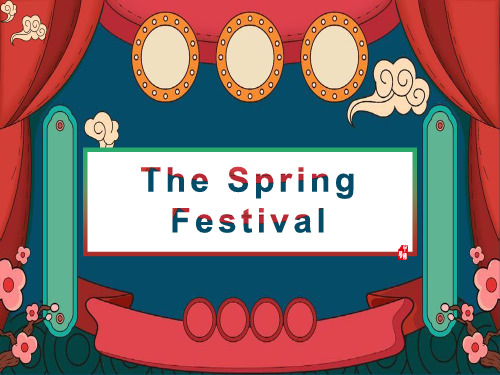
The Spring Festival is the most important festival for the Chinese people and is when all family members get together, just like Christmas in the West.
Strictly speaking, the Spring Festival starts every year in the early days of the 12th lunar month and will last till the mid 1st lunar month of the next year. Of them, the most important days are Spring Festival Eve and the first three days. Most people will have a week off , thus, this time is known as golden week.
Related vocabulary
春节传统美食 年糕 rice cake; New Year cake 团圆饭 family reunion dinner 年夜饭 New Year's Eve dinner 饺子 Jiao-zi;dumplings 汤圆 dumplings made of sweet rice 八宝饭:eight-treasure rice pudding 糖莲子 candied lotus seed 花生糖 peanut candy
Spring Festival Traditions
Firecrackers
spring-festival(春节英文介绍)课件

• 3、Eating
• There are different main courses everyday during the New Year, such as Jiao Zi (dumplings), the spring rolls, the sticky rice cakes, Tang Yuan, and so on.
Spring Festival
jerry
The Spring Festival is a traditional Chinese festival and also the most important one of the whole year, which is also called as the Chinese new year or the Lunar New Year. In china , it is called Chun Jie or Guo Nian.
• 4、New Year's Visit and Gift Money
• On the first day of the Chinese lunar year, people pay formal calls on their relatives and friends, wishing them all the luck in the coming year. Juniors will greet seniors, wishing them health and longevity, while seniors will give juniors some gift money as a wish for their safety in the coming year.
ห้องสมุดไป่ตู้
春节习俗介绍(英文版)PPT课件
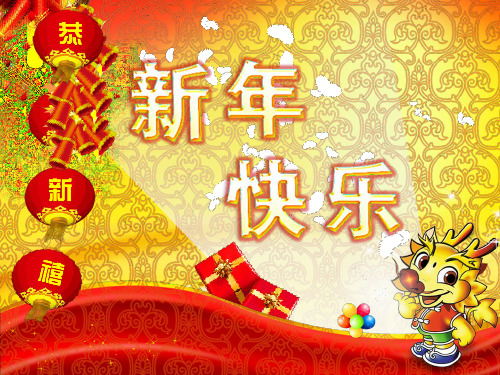
精选ppt课件2021ring Festival
❖Many customs accompany the Spring Festival. Some are still followed today, but others have weakened.
精选ppt课件2021
精选ppt课件2021
13
4.The Spring Festival Eve
精选ppt课件2021
14
5.New Year Day
❖On New Year, everybody dresses up. First they extend greetings to their parents. Then each child will get money as a New Year gift, wrapped up in red paper. ❖People in northern China will eat jiaozi, or dumplings, as they think "jiaozi" in sound means "bidding farewell to the old and ushering in the new". ❖Southern Chinese eat niangao,because as a homophone, niangao means "higher and higher, one year after another."
精选ppt课件2021
1
Content
❖Origin of the Spring Festival (legend) ❖Custom of the Spring Festival
介绍中国春节的英语演讲稿范文(精选6篇)

介绍中国春节的英语演讲稿介绍中国春节的英语演讲稿范文(精选6篇)演讲稿可以提高演讲人的自信心,有助发言人更好地展现自己。
在日新月异的现代社会中,演讲稿与我们的生活息息相关,还是对演讲稿一筹莫展吗?下面是小编整理的介绍中国春节的英语演讲稿范文(精选6篇),供大家参考借鉴,希望可以帮助到有需要的朋友。
介绍中国春节的`英语演讲稿1Chinese New Year Celebration is the most important celebration of the year. Chinese people may celebrate the Chinese New Year in slightly different ways but their wishes are almost the same; they want their.Chinese New Year Celebration usually lasts for 15 days. Celebratory activities include Chinese New Feast, firecrackers, giving lucky money to children, the New Year bell ringing and Chinese New Year Greetings. Most of Chinese people will stop the celebrating in their home on the 7th day of New Year because the national holiday usually ends around that day, however celebrations New Year.介绍中国春节的英语演讲稿2Today is the annual traditional festival in China, "Spring Festival". The morning sun was still in bed, I was like the sound of firecrackers to wake up. I get up and wash, this is my brother and sister have been wearing new clothes neat and I go to visit my grandparents and grandparents give us pay New Years call, each made a big red, I opened the door to stay, which contained a $100 bill, I like to eat honey, happy the flowers.After eating dumplings, my mother said that I dont have to write my homework today. I can play a day with my brother and sister. I am very happy after I hear it.The Spring Festival is the most important festival in China. On this day, every family has to eat dumplings, set off firecrackers, put up couplets and hang lanterns, which is the happiest and happiest day of the year.介绍中国春节的英语演讲稿3Before, I would be willing to celebrate the festival, especially the Spring Festival and the Mid Autumn Festival. However, this years Spring Festival is not the same as in previous years.Before the new year, because of the severe snow disaster in the south, many uncles and aunts did not rest on the Spring Festival and insisted on their jobs. My father didnt go home for the Spring Festival during the Spring Festival. He insisted on the first line of coal mine production, for more coal and overtime work to support the coal in the south. Coal miners made their contributions to the production and life in the south. Although my father could not go home with us for the new year, I was very happy, and I was proud of him.At eight p. m. thirty in the year, my mother and I sat on the couch to watch the Spring Festival. How wonderful the Spring Festival Gala is! Talk about the crosstalk, sing and sing in a moment, and dance in a moment. Its really busy! All of a sudden, mom asked me what I wanted in 20xx. I replied, "in 20xx, my wish is:study hard and make progress every day. I will make a careful and conscientious friend. I will become an excellent young pioneer.介绍中国春节的英语演讲稿4People away from home have come back from all sides to get together with their relatives. People who have been busy for a year have stopped to enjoy the results of their work. It is easy to put down the tension of the first semester of junior high school,and my mood is also very happy.On the thirty, every family was hung with red lanterns and red China knot, paste the full of hopes and blessings of the antithetical couplet symbol New Year paintings, everywhere filled with joy. Remember the Spring Festival, not the rain or snow, sometimes the frozen people shrink and shrink their hands. This week, Gods smile, we can taste the warm warm day, relax in the sun, and even shows several niujin."The adult is looking forward to the field, the child is looking forward to the year". The words are not false. The new year is the most happy when a child! That year, my father bought me a lot of fireworks, my mother bought a new pair of basketball shoes for my uncle, sent a skateboard to me, grandma also secretly honestly gift money to me, the best new year still can enjoy the play. Show the nature of his childhood.In this sound and laughter, time flies silently. "Five, four, three, two, one, zero! TV bell sound and put us into the new year. Suddenly, countless fireworks like a blossoming flowers bloom in the air a riot of colours, the sporadic streamer seemed to the city and village and all things for the baptism of the spring, also gives us a good omen! In the blink of an eye, the Spring Festival holiday will be full, in retrospect, I have to sincerely lamented:! Really happy new year!介绍中国春节的英语演讲稿5My Spring Festival Spring Festival with you, I am back to my hometown of henan RuNa, put a lot of all kinds of guns, a large paper gun, the flying ray, flying rockets, mine and so on.One day, I took a 30 cm high, a large diameter 20 cm, white paper gun in the snow, its power is greater than the small hand grenades, I use the lighter lit the fire, and then I quickly ran intothe house, 1, 2, 3, boom, as if the earth were to vibrate, I ran to see, have a big snow hole, larger than I had imagined. We also carried a throw of the mine into the water, a big splash soar when power is endless, blown fly up with all the ice surface, appear on the surface of the spectacular sights, a lot of black smoke from the water.In the home for the holiday really happy, I can shot, can also lead a lot of boy scouts, I in the home of a lot of fun these days. 介绍中国春节的英语演讲稿6After the new year, I can put up the spring festival couplet and put the fireworks. In the year thirty, I wrote a lot of couplets, put one on my own door, and gave my grandmother, grandma.At noon of the Spring Festival, we went to the public eating room. I said I wanted to play fireworks. My grandfather took me to a small shop and asked me to pick it up. I picked many varieties, including phoenix spreading wings, electric flowers and silver fountain. Then I ran home happily. First I took out a small umbrella, put it in the earth, lit it with a lighter, and the beautiful fireworks came out of it like a volcanic eruption. Phoenix wings like a peacock, silver fountain is really like a sparkling fountain. Its beautiful。
SpringFestival英语课教案
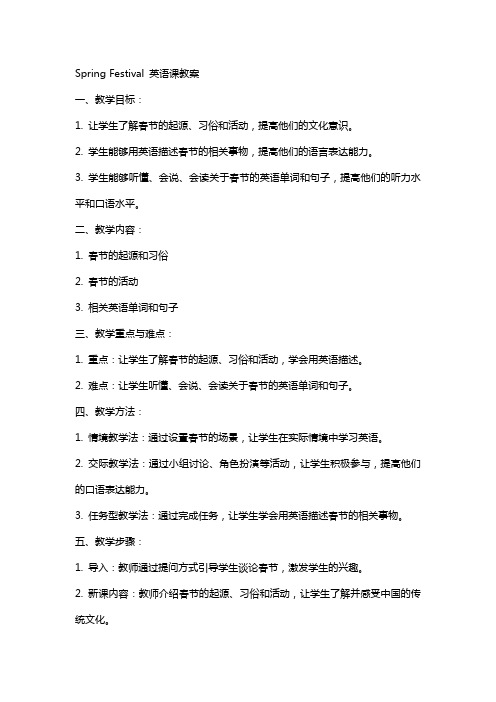
Spring Festival 英语课教案一、教学目标:1. 让学生了解春节的起源、习俗和活动,提高他们的文化意识。
2. 学生能够用英语描述春节的相关事物,提高他们的语言表达能力。
3. 学生能够听懂、会说、会读关于春节的英语单词和句子,提高他们的听力水平和口语水平。
二、教学内容:1. 春节的起源和习俗2. 春节的活动3. 相关英语单词和句子三、教学重点与难点:1. 重点:让学生了解春节的起源、习俗和活动,学会用英语描述。
2. 难点:让学生听懂、会说、会读关于春节的英语单词和句子。
四、教学方法:1. 情境教学法:通过设置春节的场景,让学生在实际情境中学习英语。
2. 交际教学法:通过小组讨论、角色扮演等活动,让学生积极参与,提高他们的口语表达能力。
3. 任务型教学法:通过完成任务,让学生学会用英语描述春节的相关事物。
五、教学步骤:1. 导入:教师通过提问方式引导学生谈论春节,激发学生的兴趣。
2. 新课内容:教师介绍春节的起源、习俗和活动,让学生了解并感受中国的传统文化。
3. 学习相关英语单词和句子:教师展示春节的相关图片,引导学生学习并运用英语描述。
4. 小组讨论:学生分成小组,讨论春节的习俗和活动,并用英语进行表达。
5. 角色扮演:学生分组进行角色扮演,模拟春节的场景,运用所学英语进行交流。
6. 听力练习:教师播放关于春节的英语听力材料,学生听后回答问题。
7. 口语练习:学生分组进行口语练习,相互提问关于春节的问题。
8. 总结与反馈:教师对学生的学习情况进行总结,并对学生进行鼓励和指导。
教学评价:通过学生的课堂表现、作业完成情况和小组讨论的结果,评价学生对春节的了解和英语运用能力。
六、教学延伸活动:1. 让学生制作春节手工艺品,如剪纸、灯笼等,并在制作过程中学习相关英语单词。
2. 举办春节文化知识竞赛,让学生通过竞赛了解更多关于春节的知识。
3. 组织学生进行春节主题的英语写作,鼓励他们用英语表达自己的观点和感受。
中国春节习俗英文版PPT讲稿
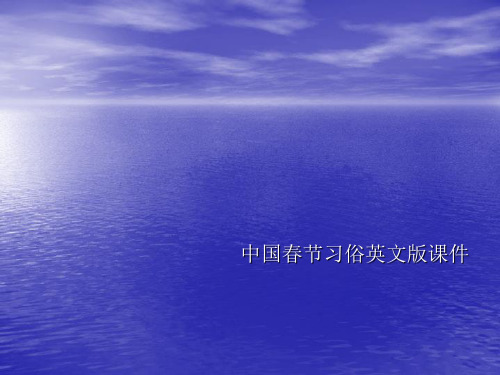
Since then,when " year" came, every family were door-closing ,pasted red couplets and burnt fireworks to drive " year" away.Then " year" never came again. People rejoiced after that ,they beat drums and mutal said congratulations , hence had Chinese New Year.
Do you know the customs in the Spring Festival ?
1. Sprs
Customs
2. Receive Gift Money
Custo ms
3.Set off fireworks
It is said that the evil spirits can be frightened to run away.
Fool’s Day
Thanksgiving Day Halloween Father’s Day
Mother’s Day
What is your attitude towards Chinese traditional festivals and western holidays??
What is the right attitude towards Chinese traditional festivals and western holidays??
Ghost Festival
festivals
The Dragon Boat Festival The Double Seventh Festival
传统节日春节英语发言稿
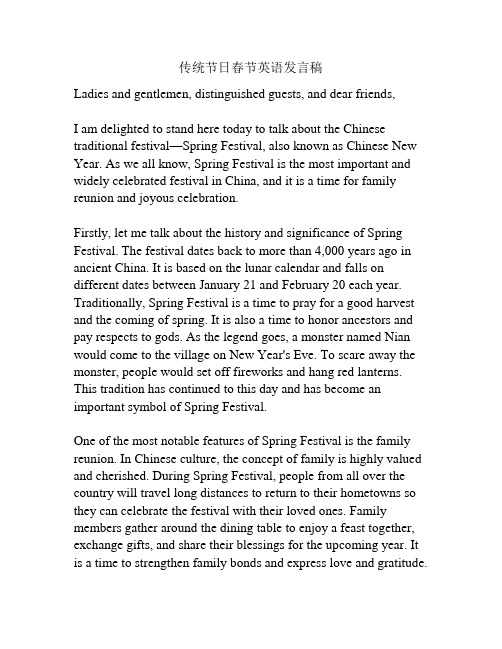
传统节日春节英语发言稿Ladies and gentlemen, distinguished guests, and dear friends,I am delighted to stand here today to talk about the Chinese traditional festival—Spring Festival, also known as Chinese New Year. As we all know, Spring Festival is the most important and widely celebrated festival in China, and it is a time for family reunion and joyous celebration.Firstly, let me talk about the history and significance of Spring Festival. The festival dates back to more than 4,000 years ago in ancient China. It is based on the lunar calendar and falls on different dates between January 21 and February 20 each year. Traditionally, Spring Festival is a time to pray for a good harvest and the coming of spring. It is also a time to honor ancestors and pay respects to gods. As the legend goes, a monster named Nian would come to the village on New Year's Eve. To scare away the monster, people would set off fireworks and hang red lanterns. This tradition has continued to this day and has become an important symbol of Spring Festival.One of the most notable features of Spring Festival is the family reunion. In Chinese culture, the concept of family is highly valued and cherished. During Spring Festival, people from all over the country will travel long distances to return to their hometowns so they can celebrate the festival with their loved ones. Family members gather around the dining table to enjoy a feast together, exchange gifts, and share their blessings for the upcoming year. It is a time to strengthen family bonds and express love and gratitude.Another significant aspect of Spring Festival is the customs and rituals associated with it. The preparation for the festival usually starts a few weeks in advance. People will thoroughly clean their houses to sweep away bad luck and make way for good fortune. Red couplets and paper-cuttings with auspicious words and patterns are hung on doors and windows to ward off evil spirits and bring good luck. On New Year's Eve, families will gather to have a reunion dinner, and they will stay up late to greet the arrival of the new year. At midnight, fireworks light up the sky, creating a festive atmosphere. Traditionally, children will receive red envelopes containing money as a symbol of good luck from their elders. It is believed that this act will bring blessings and prosperity to the recipient.Besides the family-centric celebrations, Spring Festival also offers unique cultural activities that are loved by people of all ages. For example, the lion dance and dragon dance are performed in many cities and towns during the festival. These dances are not only visually stunning but also carry significant cultural symbolism. The lion dance is believed to bring good luck and drive away evil spirits, while the dragon dance is a symbol of power and strength. In addition to these dances, there are also traditional folk performances, such as the Yangko dance and the Lantern Festival, which are activities loved by people of all ages.In recent years, Spring Festival has also become a window for the world to learn about Chinese culture. With the rapid development of technology and the increasing popularity of the internet, people from all over the world can now experience the festivities of Spring Festival through various online platforms. This has not onlypromoted cultural exchanges between China and other countries but has also increased global understanding and appreciation of Chinese traditions and customs.In conclusion, Spring Festival is a time of great joy and celebration in China. It is a festival that brings families together, strengthens ties, and promotes cultural heritage. It is not only a moment to cherish traditions and customs but also an opportunity to showcase the rich and diverse culture of China to the world. Let us all embrace the spirit of Spring Festival and extend our warmest wishes to each other for a prosperous and joyous new year. Thank you.。
春节英文说课稿模板
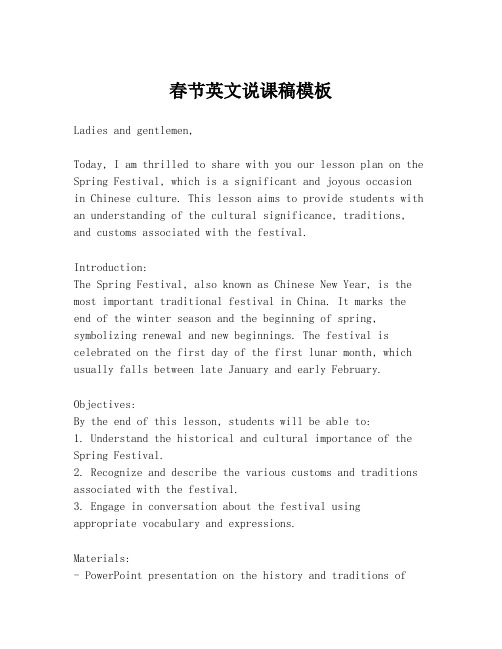
春节英文说课稿模板Ladies and gentlemen,Today, I am thrilled to share with you our lesson plan on the Spring Festival, which is a significant and joyous occasion in Chinese culture. This lesson aims to provide students with an understanding of the cultural significance, traditions, and customs associated with the festival.Introduction:The Spring Festival, also known as Chinese New Year, is the most important traditional festival in China. It marks the end of the winter season and the beginning of spring, symbolizing renewal and new beginnings. The festival is celebrated on the first day of the first lunar month, which usually falls between late January and early February.Objectives:By the end of this lesson, students will be able to:1. Understand the historical and cultural importance of the Spring Festival.2. Recognize and describe the various customs and traditions associated with the festival.3. Engage in conversation about the festival using appropriate vocabulary and expressions.Materials:- PowerPoint presentation on the history and traditions ofthe Spring Festival.- Handouts with vocabulary and phrases related to the festival.- Video clips of Spring Festival celebrations.Procedure:1. Warm-up Activity: Begin with a brief discussion about what students know about the Spring Festival. This will help gauge their prior knowledge and set the stage for the lesson.2. Presentation: Use the PowerPoint to introduce the history of the Spring Festival, its significance in Chinese culture, and the story of the mythical beast Nian, which the festival is said to have originated from.3. Vocabulary Introduction: Distribute handouts with key vocabulary such as "red envelope" (hongbao), "firecrackers" (bianpao), "lanterns" (denglong), and "dumplings" (jiaozi).4. Interactive Activity: Divide students into small groups and have them create a short dialogue using the new vocabulary. This will help reinforce the language and encourage practical application.5. Cultural Exploration: Show video clips of Spring Festival celebrations, including the lighting of fireworks, the Lion Dance, and the making of dumplings. Discuss the symbolism behind each tradition.6. Reflection and Discussion: Encourage students to reflect on the similarities and differences between the Spring Festival and their own cultural celebrations. Facilitate a class discussion to share insights.7. Wrap-up: Summarize the key points of the lesson and provide a handout with further reading and resources for students who wish to explore the topic in more depth.Assessment:Students will be assessed through their participation in group activities, their ability to use new vocabulary in conversation, and a short written reflection on the cultural significance of the Spring Festival.Conclusion:The Spring Festival is a time for family reunions, feasting, and celebration. It is a time to honor the past year and to welcome the new one with hope and joy. By the end of this lesson, students should have a deeper appreciation for this vibrant and meaningful festival.Thank you for your attention, and I look forward to afruitful and engaging lesson on the Spring Festival.[End of Lesson Plan]。
介绍春节的英文稿1分钟
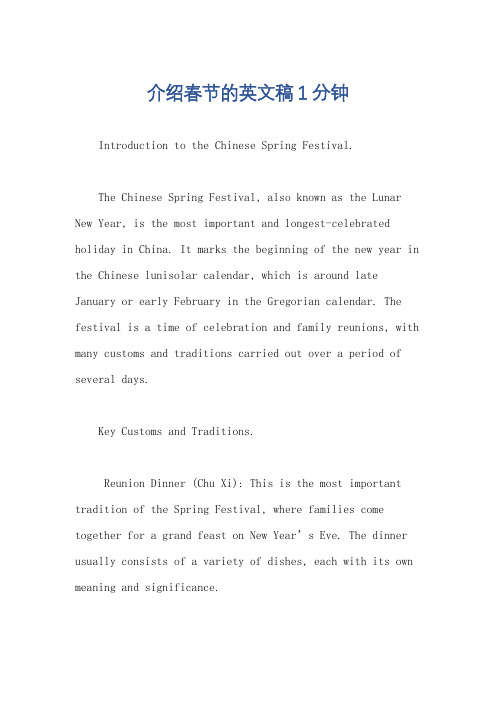
介绍春节的英文稿1分钟Introduction to the Chinese Spring Festival.The Chinese Spring Festival, also known as the Lunar New Year, is the most important and longest-celebrated holiday in China. It marks the beginning of the new year in the Chinese lunisolar calendar, which is around late January or early February in the Gregorian calendar. The festival is a time of celebration and family reunions, with many customs and traditions carried out over a period of several days.Key Customs and Traditions.Reunion Dinner (Chu Xi): This is the most important tradition of the Spring Festival, where families come together for a grand feast on New Year’s Eve. The dinner usually consists of a variety of dishes, each with its own meaning and significance.Fireworks and Firecrackers: Fireworks and firecrackers are an essential part of the Spring Festival, used to ward off evil spirits and bring good luck.Red Envelopes (Hong Bao): Red envelopes containing money are given to children and unmarried adults as a token of good fortune.Spring Festival Couplets: Couplets with auspicious messages and calligraphy are hung on doors and walls to welcome the new year.Traditional Games: Traditional games such as Chinese chess and mahjong are played during the festival.Regional Variations.The Spring Festival is celebrated differently in different regions of China, with unique customs and traditions that reflect the local culture and heritage. For example, in northern China, it is traditional to make and eat dumplings, while in southern China, it is common tohave a New Year’s cake made of glutinous rice.Historical and Cultural Significance.The Spring Festival has a long and rich history dating back to ancient China. It is believed to have originated from a combination of agricultural rituals and ancestor worship. Over time, the festival has evolved to become a symbol of Chinese culture and heritage, representing the themes of reunion, prosperity, and good luck.Contemporary Significance.In modern times, the Spring Festival remains an important holiday in China, despite the influence of Western culture. It is a time for families to come together, celebrate their heritage, and wish each other well for the new year. The festival is also an opportunity for cultural exchange and tourism, as many foreigners visit China to experience the unique atmosphere and traditions of the Spring Festival.中文回答:春节介绍。
Unit 12.《The Spring festival》(说课稿)-2022-2023学年英语五年
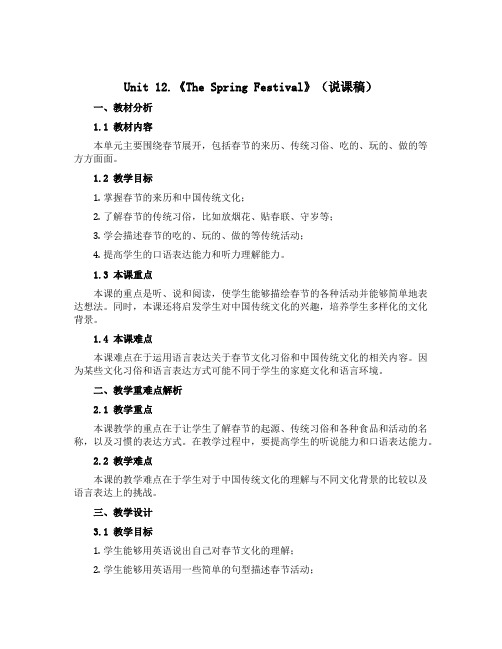
Unit 12.《The Spring Festival》(说课稿)一、教材分析1.1 教材内容本单元主要围绕春节展开,包括春节的来历、传统习俗、吃的、玩的、做的等方方面面。
1.2 教学目标1.掌握春节的来历和中国传统文化;2.了解春节的传统习俗,比如放烟花、贴春联、守岁等;3.学会描述春节的吃的、玩的、做的等传统活动;4.提高学生的口语表达能力和听力理解能力。
1.3 本课重点本课的重点是听、说和阅读,使学生能够描绘春节的各种活动并能够简单地表达想法。
同时,本课还将启发学生对中国传统文化的兴趣,培养学生多样化的文化背景。
1.4 本课难点本课难点在于运用语言表达关于春节文化习俗和中国传统文化的相关内容。
因为某些文化习俗和语言表达方式可能不同于学生的家庭文化和语言环境。
二、教学重难点解析2.1 教学重点本课教学的重点在于让学生了解春节的起源、传统习俗和各种食品和活动的名称,以及习惯的表达方式。
在教学过程中,要提高学生的听说能力和口语表达能力。
2.2 教学难点本课的教学难点在于学生对于中国传统文化的理解与不同文化背景的比较以及语言表达上的挑战。
三、教学设计3.1 教学目标1.学生能够用英语说出自己对春节文化的理解;2.学生能够用英语用一些简单的句型描述春节活动;3.学生掌握一些与春节相关的词汇;4.学生在参与课堂活动时积极表达自己的观点和意见。
3.2 教学内容(1)词汇表1.New Year’s Day:元旦;2.Spring Festival:春节;3.Red Lantern:红灯笼;4.Fireworks:烟花;5.Dumpling:饺子;6.Family Reunion:团聚;7.Good Luck:好运。
(2)语言结构1.What is your favorite Spring Festival activity?:你最喜欢的春节活动是什么?2.My favorite Spring Festival activity is…:我最喜欢的春节活动是…(3)教学方法本课采用“听说读写”综合教学方法,加入情境模拟、角色扮演、任务型教学等方法。
中国春节英语介绍Spring Festival Day
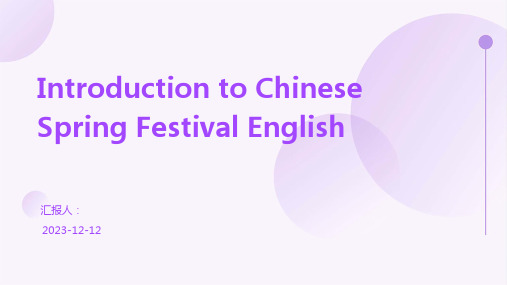
03
The History and Cultural Conno
The Historical Background of t
The historical origin of the Spring Festival: The Spring Festival originated from the annual customs of ancient agricultural societies and has a long history. In China, the Spring Festival is considered one of the most important traditional festivals and the most celebrated festival nationwide.
During the Spring Festival, dragon and lion dances are performed in the streets to celebrate the New Year These performances are believed to bring good luck and confusion to the audience
Introduction to Chinese Spring Festival English
汇报人: 2023-12-12
目 录
• The Origin and Development of • The Celebration Activities and • The History and Cultural Conno • The Celebration Methods and In
Traditional cuisine and culture
《春节介绍英文版》PPT课件
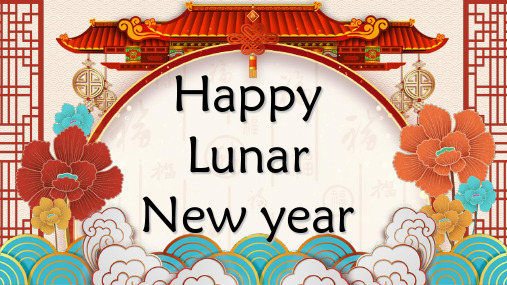
1 The legend of “nian”
2
Customs of the Spring Festival
3 Traditional food
4 Festival activites
5 Chinese zodiac
01
The legend of “nian”
The legend of nian
According to legend, there was a man-eating wild monster "Nian" with an extremely large mouth, capable of swallowing several people in a single bite.
The legend of nian
Gift money
Sweeping the dust
“dust”in Chinese means old and past. This custom shows a good wish of putting away old things to welcome a new life.
Pasting Spring Couplets
02
Customs of the Spring pring Festival
Sweeping the dust
Pasting “up-sided
Fu”
New year’s visit
Pasting Spring Couplets
Set off fireworks
Happy Lunar New year
The spring festival
It falls on the first day of the first Chinese lunar month and the celebration last from the 23rd of the 12th lunar month up to the 15th of the first lunar month next year.
介绍春节的大纲英语
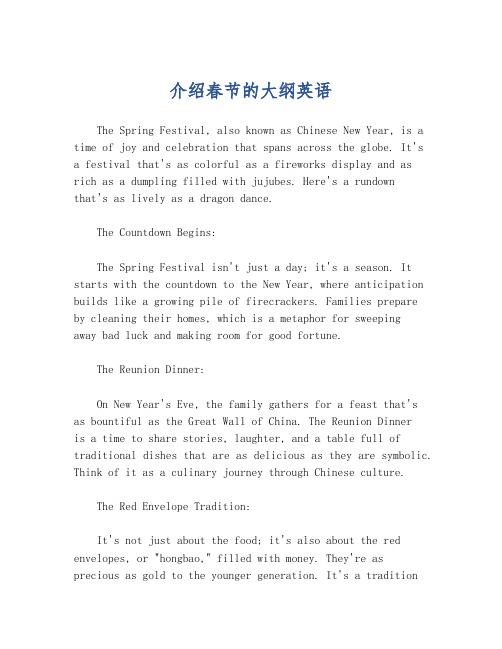
介绍春节的大纲英语The Spring Festival, also known as Chinese New Year, is a time of joy and celebration that spans across the globe. It's a festival that's as colorful as a fireworks display and as rich as a dumpling filled with jujubes. Here's a rundownthat's as lively as a dragon dance.The Countdown Begins:The Spring Festival isn't just a day; it's a season. It starts with the countdown to the New Year, where anticipation builds like a growing pile of firecrackers. Families prepareby cleaning their homes, which is a metaphor for sweepingaway bad luck and making room for good fortune.The Reunion Dinner:On New Year's Eve, the family gathers for a feast that'sas bountiful as the Great Wall of China. The Reunion Dinneris a time to share stories, laughter, and a table full of traditional dishes that are as delicious as they are symbolic. Think of it as a culinary journey through Chinese culture.The Red Envelope Tradition:It's not just about the food; it's also about the red envelopes, or "hongbao," filled with money. They're asprecious as gold to the younger generation. It's a traditionthat's as old as the festival itself, symbolizing thetransfer of luck and blessings from the elders to the younger ones.The Fireworks:As the clock strikes midnight, the sky lights up with fireworks. It's a spectacle that's as dazzling as a thousand lanterns in a festival. The fireworks are believed to scare away evil spirits and bring in the new year with a bang.The Parades:The following day, the streets come alive with parades featuring dragons and lions. It's a performance that's as vibrant as a peony in full bloom. The dragon dance is a sight to behold, a dance that's as lively as the spirits of the festival.The Lantern Festival:The Spring Festival culminates with the Lantern Festival, where lanterns light up the night like a constellation of stars. It's a night of riddles, lanterns, and sweet riceballs called "tangyuan," which symbolize unity and togetherness.The New Year Resolutions:Finally, with the festival winding down, it's time for resolutions. But instead of just making them, the Chinesetake action. They plant the seeds of their aspirations and work towards them with the same zeal as a lion in a lion dance.The Spring Festival is a tapestry of traditions, a symphony of sounds, and a feast for the senses. It's a time when the past is honored, the present is celebrated, and the future is welcomed with open arms and a heart full of hope.。
- 1、下载文档前请自行甄别文档内容的完整性,平台不提供额外的编辑、内容补充、找答案等附加服务。
- 2、"仅部分预览"的文档,不可在线预览部分如存在完整性等问题,可反馈申请退款(可完整预览的文档不适用该条件!)。
- 3、如文档侵犯您的权益,请联系客服反馈,我们会尽快为您处理(人工客服工作时间:9:00-18:30)。
S p r i n gF e s t i v a l(英文版春节介绍)Spring Festival1.Tale of NianWe call the Spring Festival Nian, but did you know that Nian was once the name of a terrible, scary monster? A long time ago, the monster Nian lived in the mountains. It looked like an ugly dragon, and got angry easily.Nian ate animals. But in winter, it could not find food. So it came to many villages and ate people. People were so afraid of Nian that they locked their doors before evening came during the winter.One day, an old man came to a village. He told people there that Nian was afraid of three things—red color, fire and noise. He told people to play drums and gongs (铜锣), make big fires and set off fireworks (放鞭炮) to make Nian go away.On a moonless, cold night, Nian went to the village again. As soon as it opened its big mouth, people made loud noises and made fires. Nian was really afraid and ran away. Wher-ever it went, there was noise and fire. When Nian was tired and could not run anymore, people killed the monster.After that, on the coldest day of winter, people beat drums and gongs, and set off fireworks to celebrate the death of the monster of Nian. They put up red lanterns (灯笼) and have a big dinner without sleeping during the night, and greet each other happily in the next morning.2.Brief Introduction of Spring FestivalThe Spring Festival is the most important festival for the Chinese people and is when all family members get together, just like Christmas in the West. All people living away from home go back, becoming the busiest time for transportation systems of about half a month from the Spring Festival. Airports, railway stations and long-distance bus stations are crowded with home returnees.The Spring Festival falls on the 1st day of the 1st lunar month. Strictly speaking, the Spring Festival starts every year in the early days of the 12th lunar month and will last till the mid 1st lunar month of the next year. Of them, the most important days are Spring Festival Eve and the first three days. The Chinese government now stipulates people have seven days off for the Chinese Lunar New Year.3.Preliminary CustomsMany customs accompany the Spring Festival. Some are still followed today, but others have weakened.On the 8th day of the 12th lunar month, many families make laba porridge, a delicious kind of porridge made with rice,glutinous rice(糯米), millet(小米), coix seed(薏仁), jujube berries(枣泥), lotus seeds(莲子), beans, longan(桂圆) and gingko(白果).The 23rd day of the 12th lunar month is called Preliminary Eve. At this time, people offer sacrifice to the kitchen god. Now however, most families make delicious food to enjoy themselves.After the Preliminary Eve, people begin preparing for the coming New Year. This is called "Seeing the New Year in".Store owners are busy then as everybody goes out to purchase necessities for the New Year. Materials not only include edible oil, rice, flour, chicken, duck, fish and meat, but also fruit, candies and kinds of nuts. What's more, various decorations, new clothes and shoes for the children as well as gifts for the elderly, friends and relatives, are all on the list of purchasing.Before the New Year comes, the people completely clean the indoors and outdoors of their homes as well as their clothes, bedclothes and all their utensils(器具).Then people begin decorating their clean rooms featuring an atmosphere of rejoicing(喜悦) and festivity(欢庆). All the door panels will be pasted withSpring Festival couplets(春联), highlighting Chinese calligraphy with black characters on red paper. The content varies from house owners' wishes for a bright future to good luck for the New Year. Also, pictures of the god of doors and wealth will be posted on front doors to ward off evil spirits and welcome peace and abundance(富足).The Chinese character "fu" (meaning blessing or happiness) is a must. The character put on paper can be pasted normally or upside down, for in Chinese the "reversed fu" is homophonic(谐音) with "fu comes". What's more, two big red lanterns can be raised on both sides of the front door. Red paper-cuttings can be seen on window glass and brightly colored New Year paintings with auspicious(吉利的) meanings may be put on the wall.People attach great importance to Spring Festival Eve. At that time, all family members eat dinner together. The meal is more luxurious than usual. Dishes such as chicken, fish and bean curd cannot be excluded, for in Chinese, their pronunciations, respectively "ji", "yu" and "doufu," mean auspiciousness(吉利), abundance andrichness. After the dinner, the whole family will sit together, chatting and watching TV. In recent years, the Spring Festival party broadcast on China Central Television Station (CCTV) is essential entertainment for the Chinese both at home and abroad. According to custom, each family will stay up to see the New Year in.4.New Year’ CustomsWaking up on New Year, everybody dresses up. First they extend greetings to their parents. Then each child will get money as a New Year gift, wrapped up in red paper. People in northern China will eat jiaozi, or dumplings, for breakfast, as they think "jiaozi" in sound means "bidding farewell to the old and ushering(迎接) inthe new". Also, the shape of the dumpling is like gold ingot from ancient China. So people eat them and wish for money and treasure.Southern Chinese eat niangao (New Year cake made of glutinous rice flour) on this occasion, because as a homophone, niangao means "higher and higher, one year after another." The first five days after the Spring Festival are a good time for relatives, friends, and classmates as well as colleagues to exchange greetings, gifts and chat leisurely.Burning fireworks was once the most typical custom on the Spring Festival. People thought the spluttering sound could help drive away evil spirits. However, such an activity was completely or partially forbidden in big cities once the government took security, noise and pollution factors into consideration. As a replacement, some buy tapes with firecracker sounds to listen to, some break little balloons to get the sound too, while others buy firecracker handicrafts to hang in the living room.The lively atmosphere not only fills every household, but permeates to streets and lanes. A series of activities such as lion dancing, dragon lantern dancing, lantern festivals and temple fairs will be held for days. The Spring Festival then comes to an end when the Lantern Festival is finished.本版附——(可否单开一页?)Spring Festival Words春节实用词汇农历lunar calendar正月lunar January (the first month by lunar calendar )除夕eve of lunar New Year元宵节The Lantern Festival春联Spring Festival couplets (two successive rhyming lines in poetry)剪纸paper-cuts年画New Year paintings守岁staying-up买年货special purchases for the Spring Festival敬酒propose a toast灯笼lantern: a portable light烟花fireworks爆竹firecrackers (People scare off evil spirits and ghosts with the loud pop.)红包red packets (cash wrapped up in red paper, symbolize fortune and wealth in the coming year.)舞狮lion dance (The lion is believed to be able to dispel evil and bring good luck.) 舞龙dragon dance (to expect good weather and good harvests)戏曲traditional opera杂耍variety show灯谜riddles written on lanterns灯会exhibit of lanterns拜年pay New Year's call; give New Year's greetings; New Year's visit禁忌taboo去晦气get rid of the ill- fortune祭祖宗offer sacrifices to one's ancestors压岁钱gift money; money given to children as a lunar New Year gift辞旧岁bid farewell to the old year扫房spring cleaning; general house-cleaning年糕Nian-gao; rise cake; New Year cake团圆饭family reunion dinner年夜饭the dinner on New Year's Eve饺子Jiao-zi; Chinese meat ravioli汤圆Tang-yuan;( dumplings made of sweet rice, rolled into balls and stuffed with either sweet or spicy fillings )八宝饭eight treasures rice pudding糖果盘candy tray:什锦糖assorted candies - sweet and fortune蜜冬瓜candied winter melon - growth and good health西瓜子red melon seed - joy, happiness, truth and sincerity金桔cumquat - prosperity糖莲子candied lotus seed - many descendents to come糖藕candied lotus root - fulfilling love relationship红枣red dates - prosperity花生糖peanut candy - sweet。
